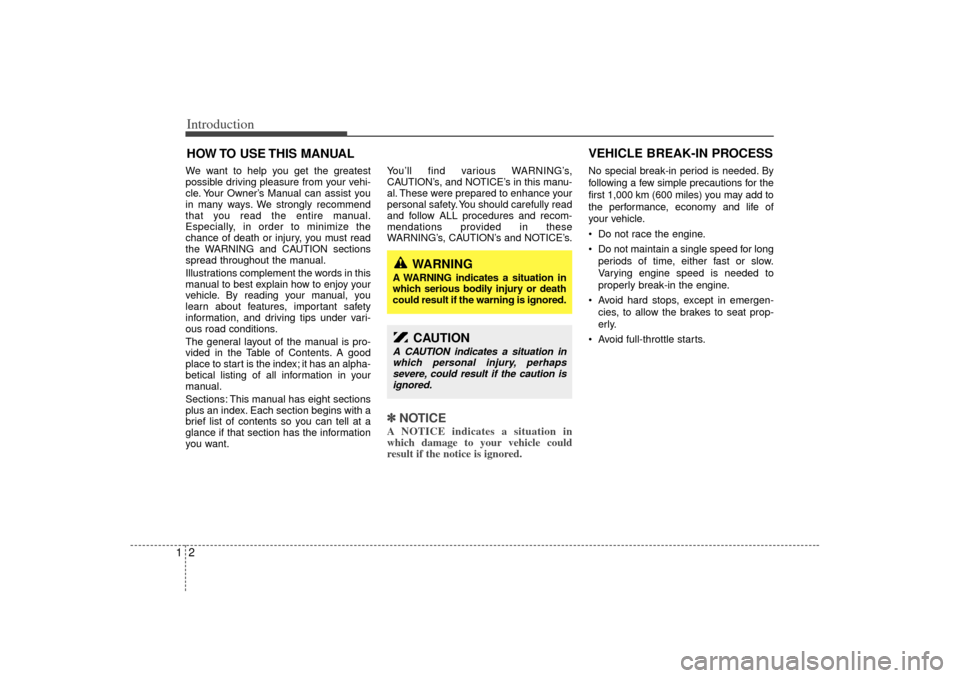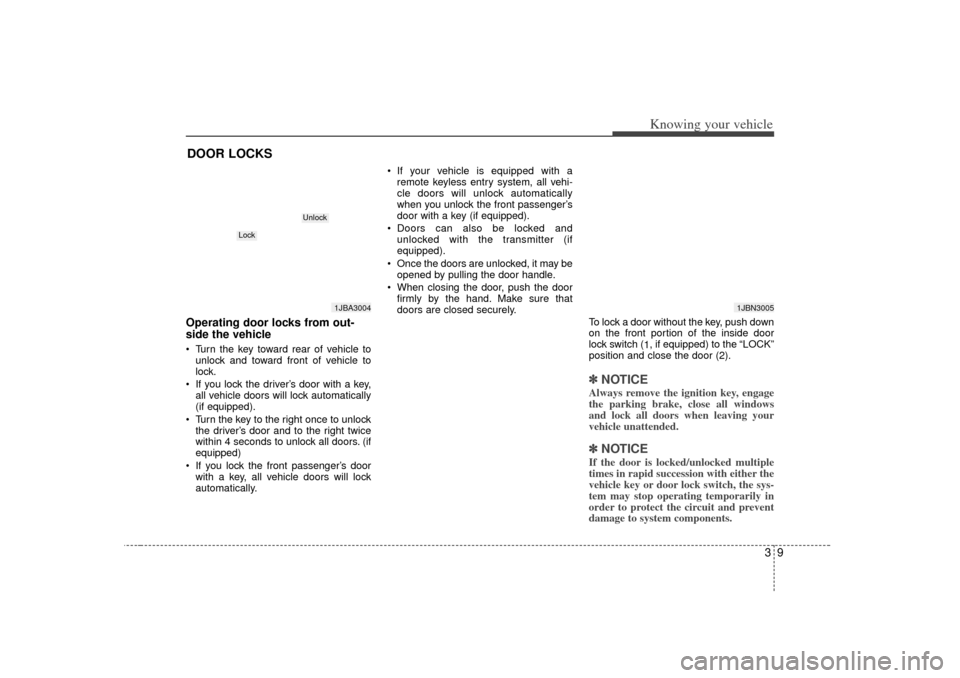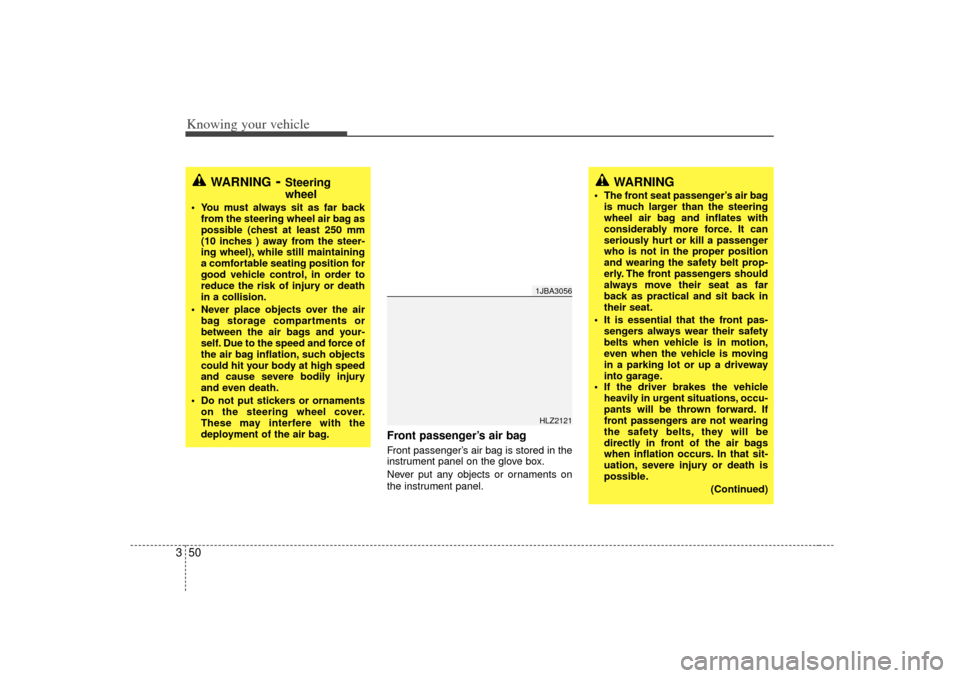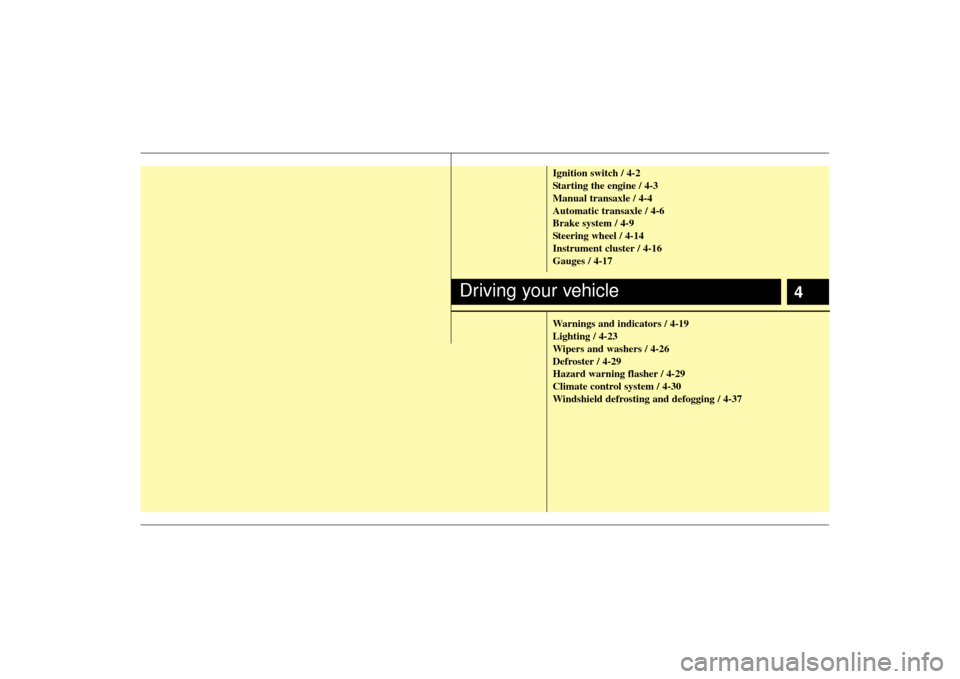2007 KIA Rio brake
[x] Cancel search: brakePage 5 of 221

Introduction21We want to help you get the greatest
possible driving pleasure from your vehi-
cle. Your Owner’s Manual can assist you
in many ways. We strongly recommend
that you read the entire manual.
Especially, in order to minimize the
chance of death or injury, you must read
the WARNING and CAUTION sections
spread throughout the manual.
Illustrations complement the words in this
manual to best explain how to enjoy your
vehicle. By reading your manual, you
learn about features, important safety
information, and driving tips under vari-
ous road conditions.
The general layout of the manual is pro-
vided in the Table of Contents. A good
place to start is the index; it has an alpha-
betical listing of all information in your
manual.
Sections: This manual has eight sections
plus an index. Each section begins with a
brief list of contents so you can tell at a
glance if that section has the information
you want.You’ll find various WARNING’s,
CAUTION’s, and NOTICE’s in this manu-
al. These were prepared to enhance your
personal safety. You should carefully read
and follow ALL procedures and recom-
mendations provided in these
WARNING’s, CAUTION’s and NOTICE’s.
✽ ✽
NOTICEA NOTICE indicates a situation in
which damage to your vehicle could
result if the notice is ignored.
No special break-in period is needed. By
following a few simple precautions for the
first 1,000 km (600 miles) you may add to
the performance, economy and life of
your vehicle.
Do not race the engine.
Do not maintain a single speed for long
periods of time, either fast or slow.
Varying engine speed is needed to
properly break-in the engine.
Avoid hard stops, except in emergen- cies, to allow the brakes to seat prop-
erly.
Avoid full-throttle starts.
HOW TO USE THIS MANUAL
WARNING
A WARNING indicates a situation in
which serious bodily injury or death
could result if the warning is ignored.
CAUTION
A CAUTION indicates a situation in which personal injury, perhaps severe, could result if the caution isignored.
VEHICLE BREAK-IN PROCESS
Page 9 of 221

Your vehicle at a glance42ENGINE COMPARTMENT
1JBA0004
1. Engine coolant reservoir ...................7-11
2. Engine oil filler cap............................7-10
3. Brake fluid reservoir ..........................7-13
4. Air cleaner .........................................7-17
5. Fuse box ...........................................6- 6
6. Negative battery terminal ...........6-4/7-21
7. Positive battery terminal .............6-4/7-21
8. Auto transaxle oil dipstick* ................7-15
9. Radiator cap......................................7-12
10. Engine oil dipstick ...........................7-10
11. Power steering fluid reservoir* ........7-14
12. Windshield washer fluid reservoir ...7-16
* : if equipped
Page 18 of 221

39
Knowing your vehicle
Operating door locks from out-
side the vehicle Turn the key toward rear of vehicle tounlock and toward front of vehicle to
lock.
If you lock the driver’s door with a key, all vehicle doors will lock automatically
(if equipped).
Turn the key to the right once to unlock the driver’s door and to the right twice
within 4 seconds to unlock all doors. (if
equipped)
If you lock the front passenger’s door with a key, all vehicle doors will lock
automatically. If your vehicle is equipped with a
remote keyless entry system, all vehi-
cle doors will unlock automatically
when you unlock the front passenger’s
door with a key (if equipped).
Doors can also be locked and unlocked with the transmitter (if
equipped).
Once the doors are unlocked, it may be opened by pulling the door handle.
When closing the door, push the door firmly by the hand. Make sure that
doors are closed securely.
To lock a door without the key, push down
on the front portion of the inside door
lock switch (1, if equipped) to the “LOCK”
position and close the door (2).
✽ ✽ NOTICEAlways remove the ignition key, engage
the parking brake, close all windows
and lock all doors when leaving your
vehicle unattended. ✽ ✽NOTICEIf the door is locked/unlocked multiple
times in rapid succession with either the
vehicle key or door lock switch, the sys-
tem may stop operating temporarily in
order to protect the circuit and prevent
damage to system components.
DOOR LOCKS
1JBA3004
Lock
Unlock
1JBN3005
Page 20 of 221

311
Knowing your vehicle
Impact sensing door unlock sys-
tem (if equipped)All doors will be automatically unlocked
when the impact is delivered to impact
sensors while the ignition switch is in the
ON position.
However, if the impact causes damage to
the vehicle electrical system or the
mechanical door lock mechanisms, the
impact sensing door unlock system may
not operate.
CAUTION
- Doors
The doors should always be fullyclosed and locked while the vehi-cle is in motion to prevent acci-dental opening of the door. Locked doors will also discour-age potential intruders when thevehicle stops or slows.
Be careful when opening doors and watch for vehicles, motorcy-cles, bicycles or pedestriansapproaching the vehicle in thepath of the door. Opening a door when something is approachingcan cause damage or injury.
WARNING
- Unlocked vehi- cles
Leaving your vehicle unlocked can
invite theft or possible harm to you
or others from someone hiding in
your vehicle while you are gone.
Always remove the ignition key,
engage the parking brake, close all
windows and lock all doors when
leaving your vehicle unattended.
WARNING
- Unattendedchildren
An enclosed vehicle can become
extremely hot, causing death or
severe injury to unattended chil-
dren or animals who cannot escape
the vehicle. Furthermore, children
might operate features of the vehi-
cle that could injure them, or they
could encounter other harm, possi-
bly from someone gaining entry to
the vehicle. Never leave children or
animals unattended in your vehicle.
Page 34 of 221

325
Knowing your vehicle
To unfold the rear seat:1. Move the rear lap/shoulder belt (1, ifequipped) to the side so that it is clear
of the seatback.
2. Lift and push the seatback backward firmly until it clicks into place (2).
3. Move and push the headrest and the seat cushion downward firmly to the
proper position (5 Door, if equipped).
4. Return the rear safety belt to the prop- er position.
✽ ✽NOTICEIf the seat belt is locked during the seat-
back folding, pull out and retract the
seat belt to release it.
1JBA3030
CAUTION
When returning the rear seat-
backs to the upright position,remember to return the rearshoulder belts to their proper position.
Do not remove the floor carpet in your vehicle. Emission controlsystem components cause highexhaust temperatures under thefloor.
WARNING
- Cargo
Cargo should always be secured to
prevent it from being thrown about
the vehicle in a collision and caus-
ing injury to the vehicle occupants.
CAUTION
Make sure the engine is off, the transaxle is in P and the parkingbrake is applied whenever load- ing or unloading cargo. Vehiclemay move if shift lever is inadver-tently moved to another position.
Be careful when loading cargo through the rear passenger seatsto prevent damage to the vehicle interior.
When cargo is loaded through the rear passenger seats, ensure thecargo is properly secured to pre-vent it from moving while driving.
Unsecured cargo in the passen-ger compartment can cause dam- age to the vehicle or injury to it’soccupants.
Page 59 of 221

Knowing your vehicle50
3
Front passenger’s air bag Front passenger’ s air bag is stored in the
instrument panel on the glove box.
Never put any objects or ornaments on
the instrument panel.
1JBA3056HLZ2121
WARNING
- Steering
wheel
You must always sit as far back from the steering wheel air bag as
possible (chest at least 250 mm
(10 inches ) away from the steer-
ing wheel), while still maintaining
a comfortable seating position for
good vehicle control, in order to
reduce the risk of injury or death
in a collision.
Never place objects over the air bag storage compartments or
between the air bags and your-
self. Due to the speed and force of
the air bag inflation, such objects
could hit your body at high speed
and cause severe bodily injury
and even death.
Do not put stickers or ornaments on the steering wheel cover.
These may interfere with the
deployment of the air bag.
WARNING
The front seat passenger’s air bagis much larger than the steering
wheel air bag and inflates with
considerably more force. It can
seriously hurt or kill a passenger
who is not in the proper position
and wearing the safety belt prop-
erly. The front passengers should
always move their seat as far
back as practical and sit back in
their seat.
It is essential that the front pas- sengers always wear their safety
belts when vehicle is in motion,
even when the vehicle is moving
in a parking lot or up a driveway
into garage.
If the driver brakes the vehicle heavily in urgent situations, occu-
pants will be thrown forward. If
front passengers are not wearing
the safety belts, they will be
directly in front of the air bags
when inflation occurs. In that sit-
uation, severe injury or death is
possible.
(Continued)
Page 66 of 221

357
Knowing your vehicle
Just before impact, drivers often brake
heavily. Such heavy braking lowers the
front portion of the vehicle causing it to
“ride” under a vehicle with a higher
ground clearance. Air bags may not
inflate in this "under-ride" situation
because deceleration forces that are
detected by sensors may be signifi-
cantly altered by such “under-ride”col-
lisions.
Air bags may not inflate in rollover acci-
dents because air bag deployment
would not provide proper protection to
the occupants.
However, side air bags may inflate
when the vehicle is rolled over by a
side impact collision, if the vehicle is
equipped with side air bags and cur-
tain air bags.
Air bags may not inflate if the vehicle
collides with objects such as utility
poles or trees, where the point of
impact is concentrated to one area and
the full force of the impact is not trans-
mitted to the sensors.
1JBA3518
1JBA3517
1JBA3522
Page 109 of 221

4
Ignition switch / 4-2
Starting the engine / 4-3
Manual transaxle / 4-4
Automatic transaxle / 4-6
Brake system / 4-9
Steering wheel / 4-14
Instrument cluster / 4-16
Gauges / 4-17
Warnings and indicators / 4-19
Lighting / 4-23
Wipers and washers / 4-26
Defroster / 4-29
Hazard warning flasher / 4-29
Climate control system / 4-30
Windshield defrosting and defogging / 4-37
Driving your vehicle